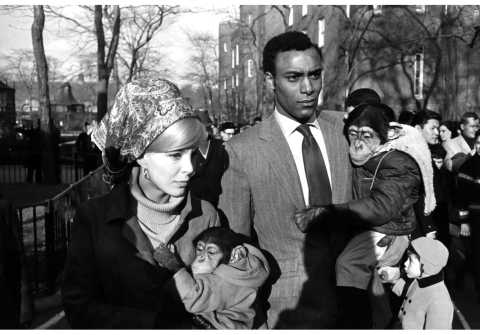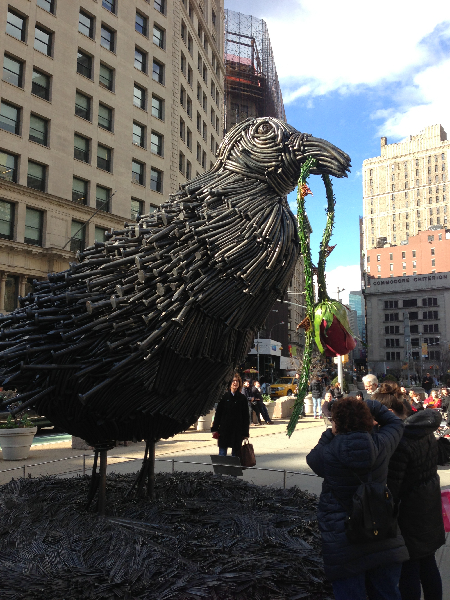Over the past few weeks, I’ve visited several artist studios, artists from the past. You can be the judge. Does being in their studio make them seem alive, as if they just left the room?
I’d say no for the Norman Rockwell Studio, where throngs of tourists encounter a guide, who has a spiel she repeats on a loop, poor thing. It’s all so neatly packaged. If the studio is intended to reveal the man, we learn next to nothing about Rockwell here. You might get a sense of that from this perfect little video, with its perky musical accompaniment.
 I rather preferred Daniel Chester French’s studio. Notice the broken windows in the skylight? Now here’s a guy who was actually working.
I rather preferred Daniel Chester French’s studio. Notice the broken windows in the skylight? Now here’s a guy who was actually working.
Yes, there’s the guide, pointing out facts about how the Lincoln maquette is scaled proportionately to the Lincoln Memorial in DC. But he also explained a French quirk–how he used his private railroad to take pieces out into the sunshine, to see how they would look in natural light. He could walk all around, study the shadows, and such.
 So here’s the sculpture on the flatbed railroad “car.” See if you can make out the tracks in my less than glorious picture. The tracks run through these huge doors to the outside…
So here’s the sculpture on the flatbed railroad “car.” See if you can make out the tracks in my less than glorious picture. The tracks run through these huge doors to the outside…
…where they dead end. They simply serve the purpose.
And he had his tools, like sample hands, at the ready.
I like this place.
Nothing quite compares to the ramshackle studio of William Kent. Kent died in 2012, but he lived and worked here until the end. A real character. No heat in that studio that had been a barn, a barn used either as a slaughterhouse or for chicken processing. Ew.
lived and worked here until the end. A real character. No heat in that studio that had been a barn, a barn used either as a slaughterhouse or for chicken processing. Ew.
Still, traveling up hill and down dale to get to this extraordinarily picturesque ruin would have inspired any artist.
Kent didn’t start out at Yale making art. He studied music with Hindemith. Interesting. His art work has pop overtones. The sculptures, his most interesting works, are made from wood from a nearby mill and definitely owe  something to Claes Oldenburg, another Yalie. His everyday household objects–the scissors, the hammer, the spade–are made of layers of various types of wood, often then add a surprise. The saw that cuts through a lightbulb or a pepper. A safety pin piercing a wooden football.
something to Claes Oldenburg, another Yalie. His everyday household objects–the scissors, the hammer, the spade–are made of layers of various types of wood, often then add a surprise. The saw that cuts through a lightbulb or a pepper. A safety pin piercing a wooden football.
Here are the tools of his trade found in his dark, crammed studio.
And a different kind of tool, the inspiration for the cartoon sculpture series.

When the New Haven schools abandoned chalkboards for marker-erase boards, he took on the chalkboards to carve as the “plate” for crudely-executed prints, sometimes transferring to fabric, as well as paper. Strongly political and conceptual in a Warhol mode, these works represent the other body of work he’s known for. He used this print as a kind of calling card, as a gift when visiting a friend’s house.
I’m leaving out the overtly sexual works Kent made, which caused a furor in buttoned-up New Haven in the 1960s. So much so that Kent lost the directorship of the child-friendly Eli Whitney Museum. A character, to be sure.
The William Kent Foundation is selling the works in the house and studio and will exist only until the last work is sold. The Foundation gives whatever money it makes to “indigent artists.” With prices that range from $6000 to $48,000 for the sculptures, the works aren’t selling too quickly. So there’s time to see this unedited studio, so revealing of the artist’s mind.
Back to the more carefully-presented, genteel, 1760s farmhouse and studios of 120 years of working artists at Weir Farm. Now we’re talking National Park Service.
 This studio is literally as pretty as a picture. It belonged to Julian Alden Weir, an Academic painter from the “tradition,” who, from 1882 on, would escape from New York each summer, and sometimes winter, to live on this farm run by a hired manager. His art and artist friends–Duncan Phillips, John Singer Sargent, Albert Pinkham Ryder, John Twachtman, Childe Hassam–followed.
This studio is literally as pretty as a picture. It belonged to Julian Alden Weir, an Academic painter from the “tradition,” who, from 1882 on, would escape from New York each summer, and sometimes winter, to live on this farm run by a hired manager. His art and artist friends–Duncan Phillips, John Singer Sargent, Albert Pinkham Ryder, John Twachtman, Childe Hassam–followed.
It’s idyllic Connecticut. It just doesn’t get any prettier than this place. Rolling hills, stone-walled  fences, gardens designed by Weir’s daughter Cora, all framed by the softest blue sky and gentlest green grass. Weir advised “go in nature and paint with a stick,” to capture the immediacy of this beauty.
fences, gardens designed by Weir’s daughter Cora, all framed by the softest blue sky and gentlest green grass. Weir advised “go in nature and paint with a stick,” to capture the immediacy of this beauty.
Yes, there’s an oddity here and there, like this dining room chandelier from the house. But mostly, what is here is Park-Service-prescribed heavenly beauty, dated 1915. Can you imagine working in a studio this pristine, this picturesque?
I walked the grounds with a printed guide to see just where Weir stood to make his paintings. Thomas Cole’s wonderful house Cedar Grove up the Hudson River offers the same tool. Magical!
Here, the artist story continues. Mahonri Young, Brigham Young’s non-religious son (yes, really), comes to Connecticut to paint and marries Weir’s daughter Dorothy, another artist. They live in the house, and
Mahonri builds a separate studio for his sculpture and painting. It’s in much rougher condition and so not as charming as its Weir neighbor.
Still, who wouldn’t love this remembrance of an adult visitor? As a child, he recalls getting in and playing in this tub of clay. Delicious!
Today, artists continue to paint en plein air here. As I was leaving, the artists, too, were wrapping up their day. A day that allowed peaceful seclusion, but also connection to like-minded spirits. An artist’s dream.















 But her art forays seemed to be subsumed, like so many other women artists, by the rigors of her daily life. Now, let us not be confused. Although she and her husband started out fairly modestly, with his lion-like courtroom successes, they soon amassed enough money to buy
But her art forays seemed to be subsumed, like so many other women artists, by the rigors of her daily life. Now, let us not be confused. Although she and her husband started out fairly modestly, with his lion-like courtroom successes, they soon amassed enough money to buy 


 One of the juicy stories told on the tour at her
One of the juicy stories told on the tour at her






































 A curator from MoMA was in town to discuss a Claes Oldenburg sculpture on the
A curator from MoMA was in town to discuss a Claes Oldenburg sculpture on the 
 We watched a film of the fabrication, done by Lippincott in North Haven nearby. That foundry also fabricated Barnett Newman’s works of broken obelisks. They apparently knew what they were doing.
We watched a film of the fabrication, done by Lippincott in North Haven nearby. That foundry also fabricated Barnett Newman’s works of broken obelisks. They apparently knew what they were doing.










 flowering, and decline–and the way community helps restore the heroine to hero status, after it’s demise. Weems takes the ordinary, the everyday joys and pains, and monumentalizes them. Don’t miss the chance to see this one.
flowering, and decline–and the way community helps restore the heroine to hero status, after it’s demise. Weems takes the ordinary, the everyday joys and pains, and monumentalizes them. Don’t miss the chance to see this one.


 y want to get over to Barrow Street to see him while you can. His over-the-top energy suits this outrageously plotted show about the coming together of a little man and the monumental Barbra Steisand. The play is full of laughs, some at the expense of stardom, most at the absurdities of people just trying to make it through life.
y want to get over to Barrow Street to see him while you can. His over-the-top energy suits this outrageously plotted show about the coming together of a little man and the monumental Barbra Steisand. The play is full of laughs, some at the expense of stardom, most at the absurdities of people just trying to make it through life.







 This console table from Houghton Hall will give you some idea of the decorative arts style. The lions show up on the British Royal Arms and are a symbol of power and courage, as well as knightly virtue. The console lion is surrounded by cornucopias of fruit and flowers, showing wealth and plenty. Of course, the blue marble slab on top is rare and precious. This table really demonstrates the British sense of itself during its empire-building years.
This console table from Houghton Hall will give you some idea of the decorative arts style. The lions show up on the British Royal Arms and are a symbol of power and courage, as well as knightly virtue. The console lion is surrounded by cornucopias of fruit and flowers, showing wealth and plenty. Of course, the blue marble slab on top is rare and precious. This table really demonstrates the British sense of itself during its empire-building years.






















